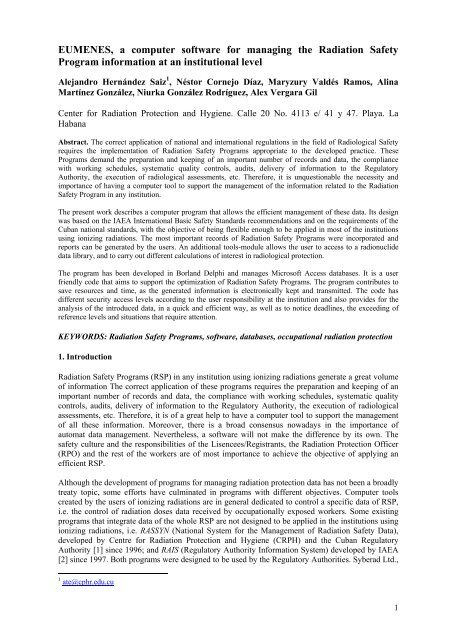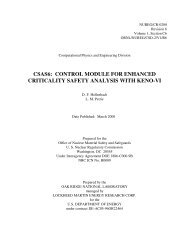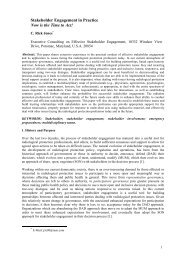EUMENES, a computer software for managing the ... - IRPA12
EUMENES, a computer software for managing the ... - IRPA12
EUMENES, a computer software for managing the ... - IRPA12
Create successful ePaper yourself
Turn your PDF publications into a flip-book with our unique Google optimized e-Paper software.
<strong>EUMENES</strong>, a <strong>computer</strong> <strong>software</strong> <strong>for</strong> <strong>managing</strong> <strong>the</strong> Radiation Safety<br />
Program in<strong>for</strong>mation at an institutional level<br />
Alejandro Hernández Saiz 1 , Néstor Cornejo Díaz, Maryzury Valdés Ramos, Alina<br />
Martínez González, Niurka González Rodríguez, Alex Vergara Gil<br />
Center <strong>for</strong> Radiation Protection and Hygiene. Calle 20 No. 4113 e/ 41 y 47. Playa. La<br />
Habana<br />
Abstract. The correct application of national and international regulations in <strong>the</strong> field of Radiological Safety<br />
requires <strong>the</strong> implementation of Radiation Safety Programs appropriate to <strong>the</strong> developed practice. These<br />
Programs demand <strong>the</strong> preparation and keeping of an important number of records and data, <strong>the</strong> compliance<br />
with working schedules, systematic quality controls, audits, delivery of in<strong>for</strong>mation to <strong>the</strong> Regulatory<br />
Authority, <strong>the</strong> execution of radiological assessments, etc. There<strong>for</strong>e, it is unquestionable <strong>the</strong> necessity and<br />
importance of having a <strong>computer</strong> tool to support <strong>the</strong> management of <strong>the</strong> in<strong>for</strong>mation related to <strong>the</strong> Radiation<br />
Safety Program in any institution.<br />
The present work describes a <strong>computer</strong> program that allows <strong>the</strong> efficient management of <strong>the</strong>se data. Its design<br />
was based on <strong>the</strong> IAEA International Basic Safety Standards recommendations and on <strong>the</strong> requirements of <strong>the</strong><br />
Cuban national standards, with <strong>the</strong> objective of being flexible enough to be applied in most of <strong>the</strong> institutions<br />
using ionizing radiations. The most important records of Radiation Safety Programs were incorporated and<br />
reports can be generated by <strong>the</strong> users. An additional tools-module allows <strong>the</strong> user to access to a radionuclide<br />
data library, and to carry out different calculations of interest in radiological protection.<br />
The program has been developed in Borland Delphi and manages Microsoft Access databases. It is a user<br />
friendly code that aims to support <strong>the</strong> optimization of Radiation Safety Programs. The program contributes to<br />
save resources and time, as <strong>the</strong> generated in<strong>for</strong>mation is electronically kept and transmitted. The code has<br />
different security access levels according to <strong>the</strong> user responsibility at <strong>the</strong> institution and also provides <strong>for</strong> <strong>the</strong><br />
analysis of <strong>the</strong> introduced data, in a quick and efficient way, as well as to notice deadlines, <strong>the</strong> exceeding of<br />
reference levels and situations that require attention.<br />
KEYWORDS: Radiation Safety Programs, <strong>software</strong>, databases, occupational radiation protection<br />
1. Introduction<br />
Radiation Safety Programs (RSP) in any institution using ionizing radiations generate a great volume<br />
of in<strong>for</strong>mation The correct application of <strong>the</strong>se programs requires <strong>the</strong> preparation and keeping of an<br />
important number of records and data, <strong>the</strong> compliance with working schedules, systematic quality<br />
controls, audits, delivery of in<strong>for</strong>mation to <strong>the</strong> Regulatory Authority, <strong>the</strong> execution of radiological<br />
assessments, etc. There<strong>for</strong>e, it is of a great help to have a <strong>computer</strong> tool to support <strong>the</strong> management<br />
of all <strong>the</strong>se in<strong>for</strong>mation. Moreover, <strong>the</strong>re is a broad consensus nowadays in <strong>the</strong> importance of<br />
automat data management. Never<strong>the</strong>less, a <strong>software</strong> will not make <strong>the</strong> difference by its own. The<br />
safety culture and <strong>the</strong> responsibilities of <strong>the</strong> Lisencees/Registrants, <strong>the</strong> Radiation Protection Officer<br />
(RPO) and <strong>the</strong> rest of <strong>the</strong> workers are of most importance to achieve <strong>the</strong> objective of applying an<br />
efficient RSP.<br />
Although <strong>the</strong> development of programs <strong>for</strong> <strong>managing</strong> radiation protection data has not been a broadly<br />
treaty topic, some ef<strong>for</strong>ts have culminated in programs with different objectives. Computer tools<br />
created by <strong>the</strong> users of ionizing radiations are in general dedicated to control a specific data of RSP,<br />
i.e. <strong>the</strong> control of radiation doses data received by occupationally exposed workers. Some existing<br />
programs that integrate data of <strong>the</strong> whole RSP are not designed to be applied in <strong>the</strong> institutions using<br />
ionizing radiations, i.e. RASSYN (National System <strong>for</strong> <strong>the</strong> Management of Radiation Safety Data),<br />
developed by Centre <strong>for</strong> Radiation Protection and Hygiene (CRPH) and <strong>the</strong> Cuban Regulatory<br />
Authority [1] since 1996; and RAIS (Regulatory Authority In<strong>for</strong>mation System) developed by IAEA<br />
[2] since 1997. Both programs were designed to be used by <strong>the</strong> Regulatory Authorities. Syberad Ltd.,<br />
1 ate@cphr.edu.cu<br />
1
a company from <strong>the</strong> United Kingdom developed <strong>the</strong> program Health Physicist's Companion, an<br />
interesting application as a radionuclide library and also to carry out different types of useful<br />
calculations [3]. Smart Data Solutions Inc., a company, with headquarters in Atlanta, Georgia, USA,<br />
has developed a Radiation Safety Database in <strong>the</strong> year 2000. This tool, named RS Solutions 2000 [4],<br />
can be applied in institutions using ionizing radiations.<br />
Eumenes makes possible <strong>the</strong> control of <strong>the</strong> main records generated during <strong>the</strong> application of a RSP.<br />
Its design was based on <strong>the</strong> IAEA recommendations [5, 6] and on <strong>the</strong> requirements of <strong>the</strong> Cuban<br />
national standards [7, 8, 9, 10, 11, 12], with <strong>the</strong> objective of being flexible enough to be applied in<br />
most of <strong>the</strong> institutions using ionizing radiations in any country. It is a supporting tool in <strong>the</strong><br />
optimization of those programs and would allow to analyze <strong>the</strong> introduced data, in a quick and<br />
efficient way, as well as to notice deadlines, <strong>the</strong> exceeding of reference levels and situations that<br />
require attention. It will also avoid some common regulatory violations that occur from poor and<br />
inefficient record keeping. Eumenes was developed in Borland Delphi and manages Microsoft<br />
Access databases. It is a user friendly code that contributes to save resources and time, as <strong>the</strong><br />
generated in<strong>for</strong>mation is electronically kept and transmitted. The code has different security access<br />
levels according to <strong>the</strong> user responsibility at <strong>the</strong> institution.<br />
The development of this <strong>computer</strong> tool and <strong>the</strong> generalization of its use in Cuba is a specific result of<br />
a R&D Project conducted by CRPH in <strong>the</strong> frame of a program with government funds, managed by<br />
AENTA (Nuclear Energy and Advanced Technologies Agency) from CITMA (Ministry <strong>for</strong> Science,<br />
Technology and Environment). The project will finish by <strong>the</strong> middle of 2009.<br />
2. Software description<br />
Eumenes comprises seven main modules. The user can access to all this 7 modules from <strong>the</strong> opening<br />
screen, see Fig.1.<br />
Figure 1. Opening screen-shot of Eumenes.<br />
1. General Options Module: Here, <strong>the</strong> user introduces <strong>the</strong> general data of <strong>the</strong> institution; see Fig.2,<br />
<strong>the</strong> authorized practices and nuclides, <strong>the</strong> Licensee/Registrant and RPO data, <strong>the</strong> logo and<br />
headings to be used in <strong>the</strong> reports. This module also allows controlling <strong>the</strong> users of <strong>the</strong> system<br />
(and <strong>the</strong>ir access level <strong>for</strong> <strong>managing</strong> <strong>the</strong> data), and changing <strong>the</strong>ir access passwords.<br />
2
Figure 2. Screen-shot with <strong>the</strong> <strong>for</strong>m to be filled with <strong>the</strong> general data of <strong>the</strong> institution.<br />
2. Radiation Protection Records Module: It allows accessing <strong>the</strong> RSP records concerning <strong>the</strong><br />
assets of <strong>the</strong> institution (see Fig.3), to display, to add, to modify or to delete data. Occupationally<br />
Exposed Workers (see Fig. 4) with, among o<strong>the</strong>rs, its exposure records 2 ; monitoring equipment,<br />
inventory of radioactive sources (see Fig. 5) and/or radiation generators, Safety Important<br />
Elements (SIE), individual protective equipment, etc. are among those records.<br />
Figure 3. Screen-shot of <strong>the</strong> Radiation Protection Records Module.<br />
2 This record includes personal data, <strong>the</strong> nature of <strong>the</strong> work involving occupational exposure, previous employs,<br />
in<strong>for</strong>mation of doses, exposures and intakes in routine work and in emergency situations, training, individual<br />
licensing and <strong>the</strong> results of <strong>the</strong> health surveillance.<br />
3
Figure 4. Screen-shot of <strong>the</strong> Occupationally Exposed Worker Record. Here <strong>the</strong> user can gain access<br />
to exposure records, training activities, individual licencing, etc.<br />
Figure 5. Screen-shot with <strong>the</strong> <strong>for</strong>m to be filled with <strong>the</strong> radioactive sources data.<br />
3. Processes Module: Through this module, <strong>the</strong> user gain access to data associated to <strong>the</strong><br />
implementation of a RSP, to display, to add, to modify or to delete <strong>the</strong>se data. The following are<br />
some of <strong>the</strong> identified processes:<br />
1. Authorization of practices.<br />
2. Doses assessment to occupationally exposed workers.<br />
3. Individual and workplace monitoring.<br />
4. Regular leak test of sealed sources.<br />
4
5. Internal and external audits.<br />
6. SIE functioning, repair and maintenance control.<br />
7. Generation and management of radioactive wastes and disused sources.<br />
8. Management of incidents and emergencies.<br />
9. Workers individual licensing process.<br />
10. Workers training.<br />
11. Health surveillance.<br />
12. Completion status and checking individual protective equipment and resources to face up<br />
emergencies.<br />
13. Movement of portable gauges, sources and radiation generators.<br />
14. Calibrations, maintenance and repair of monitoring equipment.<br />
15. Calibrations, maintenance and repair of radiation generators.<br />
4. Classifiers (codifiers) Module: It allows accessing <strong>the</strong> system classifiers. It is one of <strong>the</strong> most<br />
important elements to ensure customizing <strong>the</strong> system in any country, due to <strong>the</strong> possibility of <strong>the</strong><br />
system manager (usually <strong>the</strong> RPO) to modify (edit) <strong>the</strong>se classifiers. Through classifiers<br />
customizing, <strong>the</strong> user can adopt local terms and names. Classifiers take <strong>the</strong> <strong>for</strong>m of pull-down<br />
lists and make data entry easier; minimize errors during <strong>the</strong>se entries and allow data correlation<br />
to be used in different reports. Fig. 6 shows an example of a classifier.<br />
Figure 6. Screen-shot of Practices Classifier.<br />
5. Additional Tools Module: It groups several tools (see Fig. 7) allowing <strong>the</strong> user, among o<strong>the</strong>rs:<br />
a) To gain access to a useful nuclide library with selected data of more than 600 nuclides (see<br />
Fig. 8 and 9). Nuclides data were obtained from [5, 8, 12, 13, 14, 15].<br />
b) To carry out simple calculations usually made by <strong>the</strong> RPO. This option uses data from <strong>the</strong><br />
nuclide library. The following are some of <strong>the</strong> calculations included:<br />
• activity decay,<br />
• radiation doses received by external exposures to point gamma and neutron sources (and<br />
also o<strong>the</strong>r geometries <strong>for</strong> gamma sources),<br />
• equivalent dose by skin contamination,<br />
• committed effective doses <strong>for</strong> occupationally exposed workers an members of <strong>the</strong> public<br />
by intake of nuclides (inhalation and ingestion) and <strong>for</strong> patients by intake of<br />
radiopharmaceuticals,<br />
• time needed to clear radioactive wastes.<br />
5
6<br />
c) To create and modify check lists to be applied during internal audits of <strong>the</strong> RSP.<br />
d) To access national legislation currently in <strong>for</strong>ce.<br />
e) To gain access to in<strong>for</strong>mation about Radiation Protection Fundamentals (with training<br />
objectives).<br />
Figure 7. Screen-shot of <strong>the</strong> Additional Tools Module.<br />
Figure 8. Window of <strong>the</strong> Nuclide Library opening screen.<br />
Once <strong>the</strong> user click on “Visualizar” button, can accede several data grouped according to <strong>the</strong><br />
calculation objective (see Fig. 9).
Figure 9. Screen-shot of one of <strong>the</strong> data groups <strong>for</strong> Co-60.<br />
6. Reports and Correlations Module: Although pre elaborated reports of specific elements can be<br />
generated using <strong>the</strong> option List/Print “Listar/Imprimir” from each screen (see Fig. 10), this<br />
module allows displaying reports generated by <strong>the</strong> system. Eumenes includes reports of:<br />
classifiers, nuclide library and o<strong>the</strong>rs associated to <strong>the</strong> records of <strong>the</strong> RSP.<br />
Figure 10. Screen-shot of a report (Occupationally Exposed Workers). Note that headings and logo<br />
of <strong>the</strong> institution in <strong>the</strong> report are customized according to <strong>the</strong> in<strong>for</strong>mation previously entered.<br />
7. Help Module: It provides in<strong>for</strong>mation of <strong>the</strong> content and use of <strong>the</strong> system.<br />
7
Figure 11. General structure of <strong>the</strong> main modules of Eumenes.<br />
3. Conclusions<br />
Eumenes is a <strong>computer</strong> tool designed to be applied in institutions using ionizing radiation. The<br />
control of <strong>the</strong> several constituents of <strong>the</strong> RSP can be done at a deeper level than if it be used a system<br />
designed to be applied by <strong>the</strong> Regulatory Authority. It guarantees <strong>the</strong> reliability of <strong>the</strong> stored<br />
in<strong>for</strong>mation and reduces <strong>the</strong> time to locate it; <strong>the</strong>se advantages allow increasing efficiency in <strong>the</strong><br />
application of <strong>the</strong> RSP. All of this leads to a higher level of safety and security of practices in <strong>the</strong><br />
institution.<br />
Main features of Eumenes:<br />
1. Multiple access, controlled by <strong>the</strong> system manager (usually <strong>the</strong> RPO).<br />
2. Contains most of <strong>the</strong> principal records generated during application of a RSP.<br />
3. Possibility to create reports with selected in<strong>for</strong>mation.<br />
4. Nuclide library with selected data of more than 600 nuclides.<br />
5. Possibility to carry out useful calculations using <strong>the</strong> data in <strong>the</strong> nuclides library.<br />
6. Customized classificators.<br />
7. Access to national legislation in <strong>for</strong>ce.<br />
8. Warning signals to notice e.g.: deadlines <strong>for</strong> authorizations, equipment calibration, <strong>the</strong> exceeding<br />
of reference levels, and several situations that require attention.<br />
8<br />
ACCESS<br />
ACCESS<br />
CONTROL<br />
CONTROL<br />
RADIATION RADIATION SAFETY<br />
SAFETY<br />
PROGRAM PROGRAM RECORDS<br />
RECORDS<br />
Classif. Classif<br />
ADDITIONAL ADDITIONAL TOOLS<br />
TOOLS<br />
Logo Logo & & headings<br />
headings<br />
to to be be used used in in reports<br />
reports<br />
CUSTOMIZED CUSTOMIZED INFORMATION<br />
INFORMATION<br />
OF OF THE THE INSTITUTION<br />
INSTITUTION<br />
REPORTS<br />
REPORTS<br />
Add, Add, Add, Add , delete<br />
delete<br />
and and modify<br />
modify<br />
data<br />
data<br />
REPORTS<br />
REPORTS<br />
General<br />
General<br />
data<br />
data<br />
Areas, Areas, Areas, Areas ,<br />
rooms<br />
rooms<br />
Classif. Classif Classif. Classif<br />
REPORTS REPORTS<br />
REPORTS<br />
REPORTS<br />
Nuclide Nuclide library<br />
library<br />
View View data data Calculations<br />
Calculations<br />
ASOCIATED<br />
ASOCIATED<br />
PROCESSES<br />
PROCESSES<br />
Radiation Radiation Protection<br />
Protection<br />
Fundamentals<br />
Fundamentals<br />
(In<strong>for</strong>mation<br />
(In<strong>for</strong>mation<br />
(In<strong>for</strong>mation<br />
In<strong>for</strong>mation <strong>for</strong> <strong>for</strong> Training)<br />
Training)<br />
National National legislation legislation in in <strong>for</strong>ce<br />
<strong>for</strong>ce<br />
Classif. Classif
4. References<br />
[1]. DOMENECH, H, et al., “RASSYN: Sistema nacional de gestión de datos de seguridad<br />
radiológica”, (Proc. II Workshop on Nuclear and Radiation Safety, La Habana, Cuba), (1996).<br />
[2]. INTERNATIONAL ATOMIC ENERGY AGENCY, Regulatory Authority In<strong>for</strong>mation<br />
System (RAIS), Vienna (1997).<br />
[3]. SYBERAD Ltd., The Health Physicist’s Companion, Version 1.4.3, (2002),<br />
http://www.syberad.com and http://www.syberad.co.uk<br />
[4]. SMART DATA SOLUTIONS Inc., RS Solutions 2000, (2000),<br />
http://www.smartdatasolutions.net/<br />
[5]. FOOD AND AGRICULTURE ORGANIZATION OF THE UNITED NATIONS,<br />
INTERNATIONAL ATOMIC ENERGY AGENCY, INTERNATIONAL LABOUR<br />
ORGANISATION, OECD NUCLEAR ENERGY AGENCY, PAN AMERICAN HEALTH<br />
ORGANIZATION, WORLD HEALTH ORGANIZATION, International Basic Safety<br />
Standards <strong>for</strong> Protection against Ionizing Radiation and <strong>for</strong> <strong>the</strong> Safety of Radiation Sources,<br />
Safety Series No. 115, IAEA, Vienna (1996).<br />
[6]. INTERNATIONAL ATOMIC ENERGY AGENCY, Recommendations <strong>for</strong> <strong>the</strong> Safe Use and<br />
Regulation of Radiation Sources in Industry, Medicine, Research and Teaching, Safety Series<br />
No. 102, IAEA, Vienna (1989).<br />
[7]. MINISTERIO DE CIENCIA, TECNOLOGÍA Y MEDIO AMBIENTE, Reglamento “Normas<br />
Básicas de Seguridad Radiológica”, Resolución conjunta CITMA – MINSAP, La Habana<br />
(2002).<br />
[8]. CENTRO NACIONAL DE SEGURIDAD NUCLEAR, Resolución No. 25/98, Reglamento de<br />
Autorización de Prácticas Asociadas al Empleo de Radiaciones Ionizantes. CNSN, La Habana<br />
(1998).<br />
[9]. CENTRO NACIONAL DE SEGURIDAD NUCLEAR, “Guía para implementación de los<br />
reglamentos de seguridad en la práctica de radiografía industrial”, La Habana (2004).<br />
[10]. CENTRO NACIONAL DE SEGURIDAD NUCLEAR. Guía para la Implementación de los<br />
Reglamentos de Seguridad en la Práctica de la Medicina Nuclear. Resolución No. 33, La<br />
Habana (2001).<br />
[11]. CENTRO NACIONAL DE SEGURIDAD NUCLEAR: Guía para la Implementación de los<br />
Reglamentos de Seguridad en la Práctica de la Radioterapia. Resolución No. 34, La Habana<br />
(2001).<br />
[12]. CENTRO NACIONAL DE SEGURIDAD NUCLEAR. Guía sobre niveles de desclasificación<br />
incondicional de materiales sólidos con muy bajo contenido radiactivo y descargas de líquidos<br />
y de gases al medio ambiente, La Habana, enero (2004).<br />
[13]. OECD Nuclear Energy Agency. Janis, Version 3.0, June (2007).<br />
[14]. DELACROIX, D., Radionuclide and Radiation Protection Data Handbook 2002. Radiation<br />
Protection Dosimetry. Vol. 98 No. 1, (2002).<br />
[15]. INTERNATIONAL ATOMIC ENERGY AGENCY, Regulations <strong>for</strong> <strong>the</strong> Safe Transport of<br />
Radioactive Material, Safety Standards Series No. ST-1, IAEA, Vienna (1996).<br />
9




